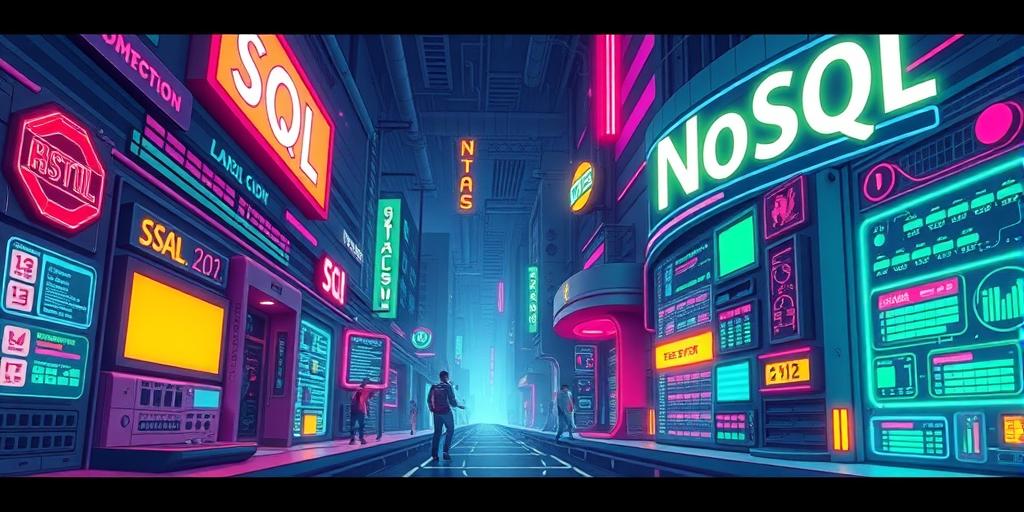Have you ever wondered about the incredible journey of data storage? From the clunky, limited systems of the past to the sprawling, dynamic databases of today, the evolution is nothing short of breathtaking. This isn’t just some techie tale; it’s a story that touches every aspect of our digital lives. Buckle up, because we’re about to explore the fascinating evolution of data storage, from the structured world of SQL to the flexible realm of NoSQL. Prepare to be amazed!
The Rise of SQL: Order in the Database
SQL, or Structured Query Language, was the undisputed king of databases for decades. Its relational model, with neatly organized tables and rows, offered a clear, predictable way to manage data. Think of a perfectly organized spreadsheet, multiplied a million times over. The benefits were immense: data integrity, consistency, and ACID properties (Atomicity, Consistency, Isolation, Durability) ensured reliability. SQL databases, like Oracle, MySQL, and PostgreSQL, became the backbone of countless applications, powering everything from banking systems to e-commerce giants. These systems thrived on structured data, fitting neatly into predefined schemas. The structured nature of SQL offered unparalleled data integrity and allowed for complex querying.
ACID Properties and Data Integrity
The ACID properties are the cornerstone of reliable SQL databases. Atomicity ensures all transactions are completed or none are. Consistency maintains data integrity following a transaction. Isolation prevents concurrent transactions from interfering with each other, maintaining data accuracy, while durability guarantees that committed data persists, even in case of system failures. This robustness made SQL a clear winner for applications where data accuracy and reliability were paramount.
The Limitations of SQL
However, as data grew exponentially – and the nature of data became far more varied – the limitations of SQL started to show. Scaling became a significant challenge; adding more data often resulted in performance bottlenecks. The rigid schema was also restrictive. Handling semi-structured or unstructured data, such as images, videos, or social media posts, became increasingly difficult and inefficient. Adapting to rapidly changing data models proved challenging. It’s akin to trying to fit a square peg into a round hole – eventually, something’s got to give!
The NoSQL Revolution: Flexibility and Scalability Take Center Stage
NoSQL databases emerged as a powerful alternative, offering solutions to SQL’s limitations. The term ‘NoSQL’ itself is somewhat misleading; it doesn’t mean ‘no SQL,’ but rather ‘Not Only SQL’. NoSQL databases embrace flexibility, scaling horizontally with ease and accommodating various data models. NoSQL databases shine when it comes to handling massive volumes of unstructured or semi-structured data. Their flexible schemas allow for easy adaptation to evolving data needs. Cloud-native NoSQL databases have significantly reduced the total cost of ownership, offering cost-effective solutions for massive datasets.
Document, Key-Value, Graph, and Column-Family Stores
The NoSQL world isn’t monolithic. Different types of NoSQL databases cater to various needs. Document databases, such as MongoDB, store data in flexible JSON-like documents. Key-value stores, like Redis, are incredibly fast for simple data retrieval. Graph databases, such as Neo4j, excel at managing relationships between data points. And column-family stores, like Cassandra, are designed for massive scalability and high availability. The choice depends on the specific application and data characteristics.
Scaling Beyond Limits
One of the most significant advantages of NoSQL is its ability to scale horizontally. Unlike SQL databases that often face performance limitations when scaling vertically (adding more resources to a single server), NoSQL databases can easily distribute data across multiple servers, allowing for near-limitless scalability. This is vital for applications handling massive data volumes, such as social media platforms or large e-commerce sites.
SQL vs. NoSQL: Choosing the Right Tool for the Job
The choice between SQL and NoSQL isn’t a case of one being inherently superior. It’s about choosing the right tool for the job. SQL remains ideal for applications requiring strong data integrity, complex relationships, and ACID properties. NoSQL shines when flexibility, scalability, and handling various data types are paramount. Many modern applications even utilize a combination of both, leveraging the strengths of each technology.
Hybrid Approaches: The Best of Both Worlds
Hybrid database approaches are becoming increasingly popular, combining the strengths of both SQL and NoSQL. This allows organizations to leverage SQL for structured data requiring high integrity while utilizing NoSQL for more flexible, scalable storage of other data types. This strategy ensures optimal performance and data management across different data requirements.
The Future of Data Storage: What Lies Ahead?
The evolution of data storage is far from over. New technologies continue to emerge, pushing the boundaries of what’s possible. Cloud-native databases are becoming increasingly prevalent, offering scalability, cost-effectiveness, and managed services. Serverless architectures are simplifying database deployment and management, reducing operational overhead. The future likely holds even more innovative approaches, further blurring the lines between SQL and NoSQL, resulting in highly adaptable and scalable solutions.
Embrace the ever-changing landscape of data storage! Stay informed about new innovations and adapt your strategies to keep up with the fast-paced world of data. Choosing the right approach can significantly influence the success of your applications and the efficiency of your data management systems. Get ready for the next chapter in data storage evolution—it’s going to be exciting!




